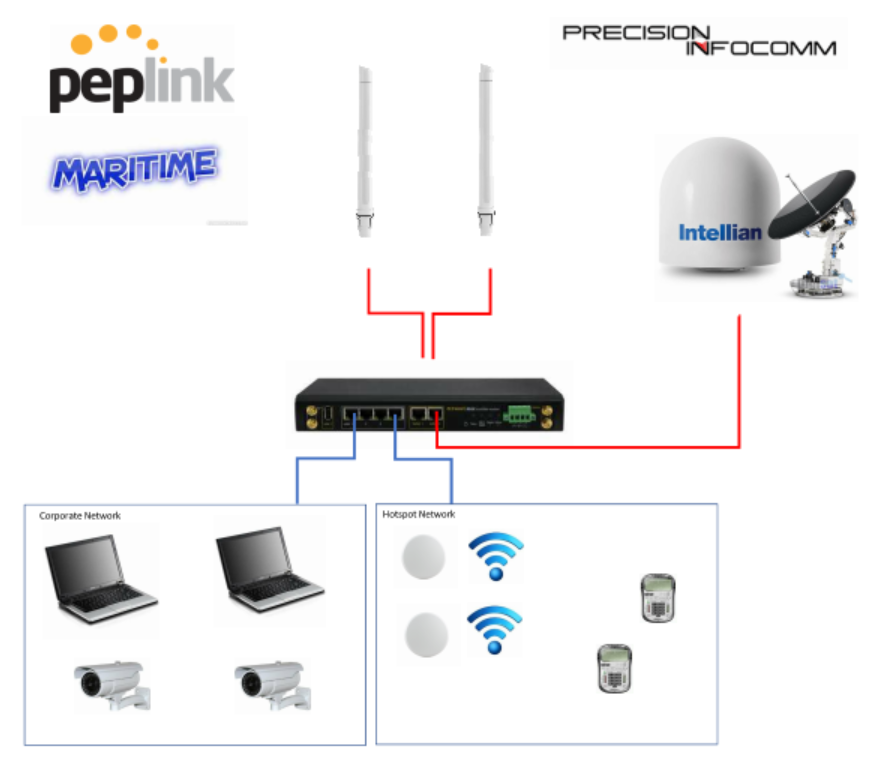
PrecisionPeplink (Speedfusion)
Categories
Peplink Fusion - A VPN Bonding Solution
VPN Bonding Solutions

Introducing Peplink Fusion
It is a network bonding technology developed by Peplink, a leading provider of SD-WAN (Software-Defined Wide Area Network) solutions. Peplink Fusion combines the bandwidth of multiple internet connections, such as wired, wireless, or satellite, into a single, high-performance connection. This innovative technology enhances network reliability, increases data transfer speeds, and improves overall network performance.
PrecisionVPN’s patented SpeedFusion technology powers enterprise VPNs that tap into the bandwidth of up to 13 low-cost cable, DSL, 3G/4G/LTE, and other links connected anywhere on your corporate or institutional WAN. Whether you’re transferring a few documents or driving real-time POS data, video feeds, and VoIP conversations, SpeedFusion pumps all your data down a single bonded data-pipe that’s budget-friendly, ultra-fast, and easily configurable to suit any networking environment.
How does Peplink Fusion work?
Peplink Fusion utilizes intelligent algorithms and advanced bonding techniques to combine the bandwidth of multiple connections seamlessly. Here's an overview of how it works:
a. Link Aggregation:
It combines multiple internet connections into a single logical connection. The technology utilizes link aggregation protocols, such as WAN Smoothing and SpeedFusion Bonding, to distribute traffic across the available connections effectively.
b. Packet-level Bonding:
It splits data packets into smaller units and distributes them across the available connections. This process ensures that packets are transmitted concurrently over multiple links, maximizing bandwidth and reducing latency.
c. Intelligent Load Balancing:
It intelligently balances traffic across the available connections based on factors such as link quality, latency, and available bandwidth. This dynamic load balancing ensures optimal utilization of all connections and improves overall network performance.
d. Seamless Failover:
In the event of a connection failure or degradation, it seamlessly switches the traffic to the remaining active connections. This failover mechanism ensures uninterrupted network connectivity and minimizes downtime.
Applications of Peplink Fusion
Peplink Fusion finds applications in various industries and scenarios where reliable, high-speed connectivity is critical. Some common applications include:
a. Business Continuity:
It is ideal for businesses that require uninterrupted connectivity for mission-critical applications. It ensures that essential services, such as VoIP, cloud applications, and remote access, remain operational even during connection outages.
b. Live Streaming and Broadcast:
It is widely used in live streaming and broadcast applications, where high-bandwidth and low-latency connections are essential. It allows broadcasters to aggregate multiple connections for reliable and high-quality streaming, even in challenging environments.
c. Remote Monitoring and Surveillance:
It is utilized in remote monitoring and surveillance applications, enabling real-time video feeds, data transmission, and remote control of surveillance systems. It ensures continuous and reliable connectivity for remote monitoring stations and improves situational awareness.
Benefits of Peplink Fusion
Peplink Fusion offers several benefits to organizations and individuals seeking enhanced network performance and reliability:
a. Increased Bandwidth:
By combining multiple internet connections, it significantly increases the available bandwidth, allowing for faster data transfer speeds and improved network performance.
b. Improved Reliability:
It provides redundancy and failover capabilities, ensuring uninterrupted connectivity even if individual connections experience failures or degradation.
c. Enhanced Performance:
It's intelligent load balancing and packet-level bonding techniques optimize network traffic distribution, resulting in reduced latency and improved overall network performance.
d. Cost Savings:
Businesses can utilize multiple low-cost internet connections instead of relying solely on expensive dedicated lines. This cost-effective approach allows organizations to achieve higher bandwidth and reliability without significant investment.
e. Flexibility and Scalability:
Highly flexible, it can be easily deployed and scaled to meet changing business requirements. It supports a wide range of connection types, including wired, wireless, and satellite, providing flexibility in connectivity options.
f. Simplified Management:
It is managed through an intuitive and centralized management interface, allowing administrators to monitor and control the network easily. It provides visibility into network usage, connection health, and performance metrics.
To learn more visit Peplink website now!

